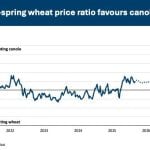Commercial farming is The Western Producer’s bread and butter, whether it be canola production, cattle ranching or beekeeping.
However, occasionally we also dabble in agriculture’s interesting fringes — one of them being farming in the city.
It could be argued that the very first urban agricultural producers were backyard gardeners, but since then the idea of growing food in cities has become much more sophisticated.
For example, the Producer has written stories over the years about companies that make arrangements with homeowners to use bits and pieces of unused land scattered across a city to effectively create urban market gardens.
Read Also

Invigor Gold variety viewed as threat to condiment mustard
Invigor Gold, the canola-quality mustard developed by BASF, is on a collision course with Canada’s condiment mustard industry. It’s difficult to see how the two can co-exist.
We’ve also covered a major hotel chain that developed vegetable gardens on the roofs of its hotels to supply their kitchens, including the Royal York in Toronto.
However, the concept of growing food in the city recently took a giant step higher.
The Globe and Mail has been focusing on the thorny question of how to revitalize Calgary’s failing downtown, and a couple Saturdays ago it highlighted four options under consideration.
The problems facing the city’s business district are dire. It is chock full of towering office buildings that are emptying out, partly because of COVID-19 but also because of the changing energy sector. One of those skyscrapers is said to be completely empty.
There has been a lot of talk about converting these office towers to apartments and condos, but others wonder about the wisdom of doing that if there’s no downtown work for the residents of these new condos.
This is where it gets interesting.
Modern Office of Design and Architecture has proposed converting some of these skyscrapers so that they can accommodate an intriguing blend of indoor farming and data centres.
The data centres, which are basically massive networks of computer systems, would create a lot of heat. This would be used to grow plants in up to 70 percent of the buildings.
Not only would this make these buildings sustainable and carbon friendly, but the food that is produced could feed all those residents that are being enticed to move downtown and live in some of the other empty office buildings.
The server farms and agricultural operations would also create jobs for some of the new residents.
Such a proposal, if it came to fruition, could indeed take urban farming to new heights.















